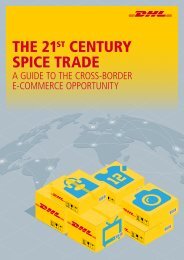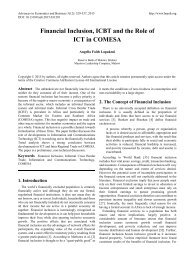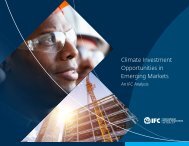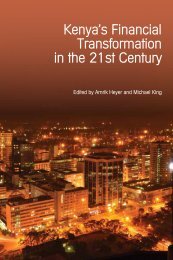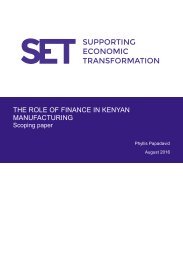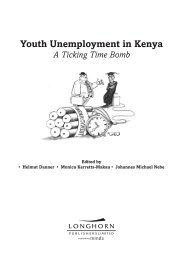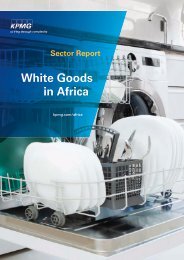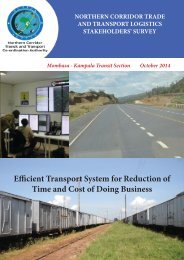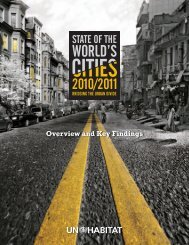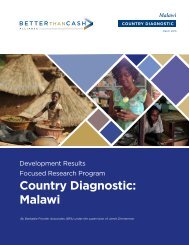FD
gvti301SEaf
gvti301SEaf
You also want an ePaper? Increase the reach of your titles
YUMPU automatically turns print PDFs into web optimized ePapers that Google loves.
Tight control<br />
The use of capital controls was widespread during the Bretton Woods<br />
era.<br />
(index)<br />
1.0<br />
0.8<br />
0.6<br />
0.4<br />
0.2<br />
Advanced economies<br />
Inflow<br />
Outflow<br />
Emerging market economies<br />
(index)<br />
1.0<br />
0.8<br />
Inflow<br />
Outflow<br />
0.6<br />
0<br />
0<br />
1950 60 70 80 90 2000 10 1950 60 70 80 90 2000 10<br />
Source: Authors' estimates based on various issues of the IMF's Annual Report on Exchange<br />
Arrangements and Exchange Restrictions.<br />
Note: Advanced economies include the G7 countries (Canada, France, Germany, Italy, Japan, United<br />
Kingdom, United States). Emerging market economies include the major emerging markets that were<br />
IMF members in 1950 (Argentina, Brazil, Chile, Colombia, Ecuador, Egypt, India, Indonesia, Korea,<br />
Malaysia, Mexico, Pakistan, Peru, Philippines, South Africa, Thailand, Tunisia, Turkey, Uruguay, Venezuela).<br />
Index is average for the respective country groups (for each, 0 = no restrictions and 1 = highly<br />
restrictive, based on the authors' judgment).<br />
might be devalued imposed restrictions on short-term<br />
inflows. For example, Australia embargoed short-term<br />
borrowing and imposed deposit requirements on other<br />
borrowing; Japan tightened controls on portfolio inflows<br />
and imposed marginal reserve requirements on nonresident<br />
deposits; Germany imposed a cash deposit requirement on<br />
foreign loans and suspended interest payments on nonresident<br />
deposits; and Swiss banks agreed not to pay interest on<br />
foreign deposits or invest foreign capital in domestic securities<br />
and properties.<br />
By 1974, with the dollar floating, the United States abandoned<br />
its outflow controls. Confident that the United States<br />
would always be able to attract investors—and that capital<br />
flows would force surplus countries to adjust by appreciating<br />
their currencies—U.S. policymakers unreservedly embraced a<br />
liberal international regime for private capital flows. Reversing<br />
the thinking of Keynes and White at Bretton Woods, they also<br />
sought to put trade in financial assets on the same footing as<br />
trade in goods and services, inserting the phrase “the essential<br />
purpose of the international monetary system is to provide<br />
a framework that facilitates the exchange of goods, services,<br />
and capital among countries” when the IMF’s Articles were<br />
amended in 1978 to legitimize floating exchange rates.<br />
Financial openness in the Anglo-Saxon countries received a<br />
further boost in the early 1980s from the free market doctrine<br />
of U.S. President Ronald Reagan and U.K. Prime Minister<br />
Margaret Thatcher. In continental Europe, a major turning<br />
point came with French President François Mitterrand’s 1983<br />
anti-inflationary policies and the realization that controls on<br />
capital outflows disproportionately penalized middle-class<br />
investors less able than the rich to evade them (Abdelal, 2006).<br />
Most French outflow controls were thus lifted during 1984–86,<br />
with full capital account liberalization by 1990.<br />
This shift in attitude had major repercussions beyond<br />
France as three officials from the same Socialist administration<br />
went on to key positions in international institutions<br />
where they promoted capital account liberalization: Henri<br />
Chavranski, at the Organisation for Economic Co-operation<br />
0.4<br />
0.2<br />
and Development, where he broadened the Code of Liberalization<br />
to cover all cross-border capital movement, including<br />
short-term flows that had originally been excluded; Jacques<br />
Delors, at the European Commission, where he championed<br />
the Directive abolishing restrictions on capital movement;<br />
and Michel Camdessus, at the IMF, where he sought an<br />
amendment of the Articles to give the IMF jurisdiction over<br />
the capital account and the mandate to liberalize it.<br />
Emerging consensus<br />
As advanced economies began to liberalize during the 1960s<br />
and 1970s, the trend in emerging market and developing<br />
economies was the opposite—mainly restricting capital<br />
outflows to help keep down domestic sovereign borrowing<br />
costs. Even some measures that could be classified as inflow<br />
controls because they were likely to discourage inward investment<br />
(such as minimum investment periods or limits on the<br />
pace or amount of repatriation) were intended to prevent a<br />
sudden reversal of capital inflows and balance of payments<br />
deficits. By the early 1970s, however, inflow restrictions of a<br />
“prudential” nature began to appear. These more explicitly<br />
aimed to safeguard economic and financial stability from<br />
excessive foreign borrowing and inflow-fueled credit booms.<br />
Liberalization in emerging markets started about a decade<br />
later than in advanced economies, under a broader predisposition<br />
toward free markets and a desire to subject government<br />
policies to the discipline of the market (the so-called Washington<br />
Consensus). But as some emerging market economies<br />
liberalized their domestic financial markets and outflow<br />
controls in the late 1970s and early 1980s, they also swept away<br />
many of the existing prudential inflow measures. The result was<br />
massive inflow-fueled booms, followed by severe economic and<br />
financial busts.<br />
This experience helped shape policy responses when inflows<br />
to emerging markets resumed in the early 1990s, and led to a<br />
marked shift in the preference for longer-term, nondebt flows.<br />
Several countries—notably Brazil, Chile, Colombia, Malaysia,<br />
and Thailand—experimented with inflow controls in the<br />
1990s. Yet such measures were not viewed favorably, and the<br />
general trend during much of the 1990s was toward greater<br />
capital account openness, culminating in IMF Managing<br />
Director Camdessus’s 1995–97 initiative to give the IMF jurisdiction<br />
over, and the mandate to liberalize, the capital account.<br />
In the end, the amendment never passed, partly because of<br />
opposition from emerging market and developing economies<br />
alarmed by the unfolding east Asian crisis and concerned that<br />
the IMF would use its new mandate to force premature liberalization<br />
on reluctant countries. Regardless, the IMF’s policy<br />
advice—in contrast to the vision of Keynes and White—had<br />
moved away from viewing capital controls as an essential tool<br />
to manage destabilizing speculative flows. An IMF Independent<br />
Evaluation Office review in 2005 found that the IMF<br />
staff had recommended tightening inflow controls in just 2 of<br />
19 instances when emerging market economies experienced<br />
large capital inflows.<br />
Despite the general disapproval, several emerging market<br />
economies restricted inflows during the mid-2000s surge. In<br />
50 Finance & Development June 2016



